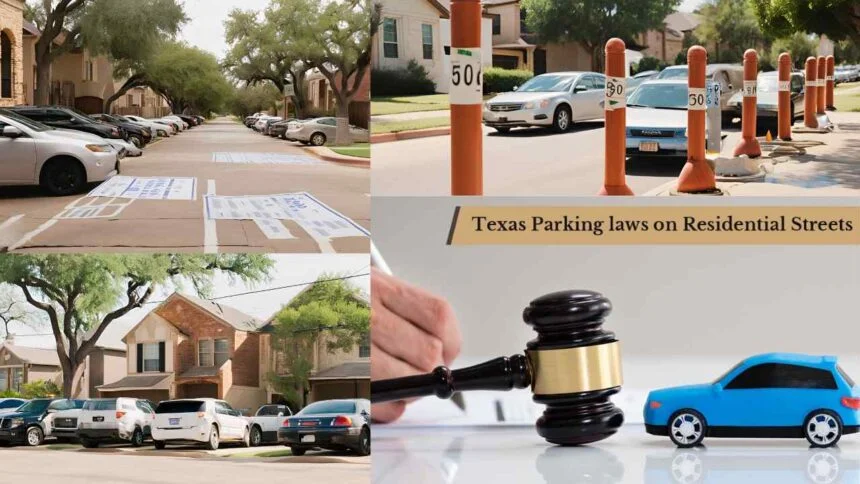Parking laws can be complex and vary significantly from one place to another. In Texas, understanding the specifics of parking laws on residential streets is crucial to avoid hefty fines and towing hassles. This comprehensive guide will provide details on the particulars of Texas Parking Laws on Residential Streets, enforcement practices, and the consequences of violations.
Texas, which is known for its wide spaces and suburbs that spread over a large area, has residents who are known to utilize on-street parking. However, this convenience creates a lot of confusion on the rules regarding parking on a residential street. As the state has a general legal framework, local municipalities also make their own rules, which leads to a lot of confusion.
In this article, you will learn about the rules and regulations regarding parking laws in Texas, especially on residential streets. According to the best corporate law firm, it will also help you avoid any potential tickets or fines.
Texas Residential Parking Challenges
Many people face parking problems on residential streets in Texas on a daily basis. Parking violations can result in fines, neighbour disputes, and vehicle towing. For new residents or those not familiar with the local laws, the lack of clarity around these rules can be especially frustrating.
The Consequences of Breaking Texas Parking Laws on Residential Streets
Parking violations can result in various penalties. In Texas, fines for parking violations can range from $25 to $200 depending on the offence and the number of times you’ve violated. In extreme cases, like parking in front of fire hydrants or blocking driveways, vehicles can be towed, adding to the financial and logistical headaches for the vehicle owner.
Parking Regulations Prescribed by the State
The Texas Transportation Code is a set of rules and regulations about parking all over the state. According to the top corporate law firms, you should remember the following important points in this law:
General Rule:
If there are no posted signs or signboards, you can park a vehicle on the right side of the road with the flow of traffic within 12 inches of the curb.
Distance Restrictions:
There are certain areas where you are supposed to maintain a safe distance while parking. These include:
- Driveways: You cannot park within 20 feet of a driveway entrance.
- Fire Hydrants: You should park your vehicle 15 feet away from a fire hydrant.
- Intersections: While driving in an intersection, you should maintain a distance of at least 30 feet from a stop sign, yield sign, flashing beacon, or traffic control signal.
- Crosswalks: You should park your vehicle at least 20 feet away from a crosswalk at an intersection.
- Fire Stations: If you are parking your vehicle at a fire station, it should maintain a distance of a minimum 20 feet from its entrance.
Prohibited Zones:
There are certain areas where you are not supposed to park your vehicles, such as:
- Sidewalks: You can’t park on a sidewalk as it can create a hurdle for pedestrians using them.
- Double Parking: It is very unsafe to park next to another parked vehicle.
- Medians: These are designated centre dividers where you are not allowed to park your vehicle.
- Posted Signs: There are posted signs available in any area that you are supposed to follow. You should avoid parking at “No Parking” zones, time limits, and designated permit areas.
Rules and Regulations Specific to Each City
While the Texas Transportation Code is just a basic foundation, you should keep in mind that municipalities have the authority and responsibility to implement additional parking regulations. These variations in laws as per each region can have a significant impact on the way you park a vehicle. Here are the following ways in which you can stay informed:
- Websites of Each City: Many cities in Texas have websites that have comprehensive sections showcasing parking regulations. They often include parking maps that can be downloaded. These maps will highlight prohibited zones and permit requirements.
- Traffic Signs: You should pay close attention to the signs and symbols that are posted on residential streets. These signs replace the state law and clearly communicate the rules and regulations of local parking.
- Community Outreach: There are many informational sessions and distribute flyers or posters that describe parking regulations in residential areas.
Austin, a town in Texas, is a great example where overnight parking on residential streets is strictly prohibited between 2 AM to 6 AM. If you want to park your vehicle in such areas, you may need to acquire a special permit to do so.
Things You Need to Keep in Mind for Permits and Overnight Parking
Here are some of the following things you should consider if you want to park your vehicles overnight in any residential street of Texas:
Residential Parking Permits:
There are some neighborhoods in Texas that enforce residential parking permits. These permits allows residents to park on designated streets in their neighborhood. You just need to get in touch with your local municipality or neighborhood association to know further about the availability of these permits and their application procedures.
Overnight Parking:
As it is mentioned above, overnight parking on residential streets is prohibited by some cities in Texas. These restrictions can widely differ according to each city. So, you need to be sure to check the local laws. Some cities can offer designated parking areas or require obtaining a temporary permit for overnight guests.
Why Do You Need to Seek Clarification on These Laws?
If you are doubtful about the regulations, it is essential to seek clarifications about them. It will help you avoid any errors, fines or tickets. You can also do the following things:
Enquiring With Local Law Enforcement:
You should courteously enquire with a local police officer, who can clarify any doubts you may have on these rules.
311 Non-Emergency Number:
A lot of cities in Texas have a 311 Non-Emergency number where you can contact a dedicated person and seek clarifications about parking regulations.
Things To Keep in Mind While Parking in a Neighborhood
It is important to understand parking regulations. However, it is much more important to park your vehicle in a decent and more considerate manner. You can follow the tips given below to do so:
- Park your vehicle while keeping its position in mind to avoid blocking driveways or mailboxes.
- Avoid parking at someone’s designated driveway or visitor spot unless they give you explicit permission for the same. While you are parallel parking your vehicle, you should avoid driving the vehicle in such a way that can disrupt the traffic pattern.
- You should also avoid loud car alarms engine noise, specifically during late-night arrivals or departures.
- If you have a personal parking space, use that space, which will in turn free up a significant area for street parking. It is also beneficial for visitors who may not have designated spots for parking.
Final Verdict
Parking a vehicle is not a tough task as many of us perceive to be. At the same time, you also need to understand the rules and regulations laid out by the state of Texas and its various municipalities, which will make it easy for you to park your vehicles without any problem. It will also help you free a lot of space and ensure there is no disruption of traffic.





